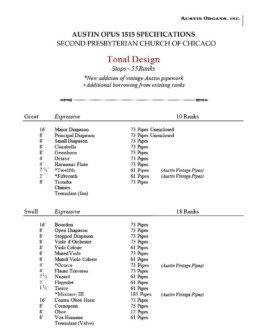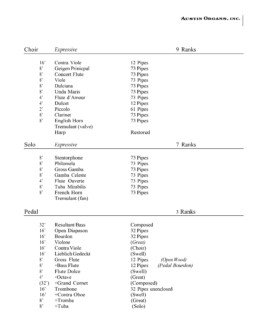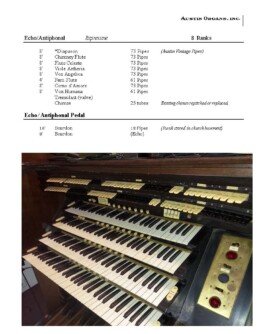
Second Presbyterian Church of Chicago is happy to announce that for the first time since 1873 we will be getting a “new” organ! The church has purchased a vintage 1929 Austin Organ, Opus 1515, from St. Luke’s Missionary Baptist Church right here in Chicago (formerly Eighteenth Church of Christ Scientist), and has signed a contract with the Austin Organ Company of Hartford, Connecticut to restore and reconfigure the organ for Second Presbyterian Church. The organ has already been removed from St. Luke’s MB Church and is at the Austin shop in Hartford. Installation of the restored organ is expected to take place in early 2026.
The current organ at Second Presbyterian consists of pipes from the organ companies of Johnson & Son (1873), Farrand & Votey (late 1800s), and Hutchings-Votey (1901). Each of these companies “rebuilt” the existing organ, removing some ranks of pipes and adding other ranks of pipes of their own. At the time the organ was originally built, the standard pitch was A435, lower than the current standard of A440. In 1917, the Austin Organ Company rebuilt the organ, adding a Solo windchest and a four manual console (the same one we use today). The Solo division was created by shifting ranks of pipes to the Solo from other divisions of the organ. At the time of the 1917 rebuild, the organist at Second Presbyterian, Albert McCarrell, suddenly requested that Austin “repitch” the organ to A440. An internal correspondence dated September 23, 1917 from the Chicago Austin Organ representative to the Austin home office stated that “McCarrell should have informed me of this as I did not think he would change pitch on this old organ.” The pitch change was apparently too costly to do, as it was never done and the organ remains at A435 pitch today. This causes a great deal of difficulty when trying to use the organ with an orchestra or other solo instruments because if is difficult for some instruments to tune to the low pitch of the organ. For several years the organ has been deteriorating. The organ console contacts are failing, and much releathering of windchests is needed. After getting a proposal to make all of the necessary repairs, it was decided that it did not make sense to pour more money into the existing organ, and still have the problem of the A435 pitch. This is when we became aware of the organ at St. Luke’s MB Church as a possible replacement for our current organ.
Eighteenth Church of Christ Scientist signed a contract with the Austin Organ Company in 1927 before their new church building was completed. The contract stated that an English Horn stop and and Echo Division would be “prepared for.” However, by the time the building was completed and the organ installed in 1929, they had decided to proceed with the installation of the Echo Division and the English Horn. The organ was designed in collaboration with Whitmer Byrne, organist at Eighteenth Church and a prominent Chicago recitalist at the time. The organ is 4 manuals, 48 ranks, and is in completely original condition, including the original console. The organ was used until Eighteenth Church closed around 1970, after which the building was purchased by St. Luke’s MB Church, which did not use the organ. The organ blower and motor was submerged in water during a basement flood at some point in time and was completely rusted and inoperable; otherwise the organ was in pristine condition.
The Austin Organ Company will reconfigure the organ to fit behind our existing organ screen and the Echo chamber in the balcony, and will build a completely new winding system with new windchests. There will be no modifications to the original stoplist, however the Austin Company will make some judicious additions using vintage Austin pipework, after which the organ will be 55 ranks. The original console will be restored, fitted with solid state combination action, and made movable in the choir loft. And to answer the question which has been asked the most–yes, we WILL be keeping the Eigenschenk Thunder Stop!
If you would like to make a contribution to help with the restoration of this historic 1929 Austin organ, please click on the “Donate” button at the top of this page.
The detailed stoplist of the new organ is shown above.


